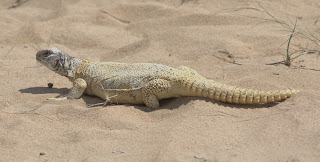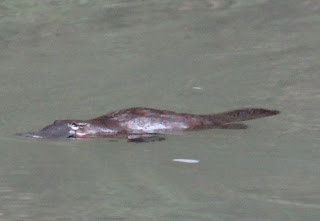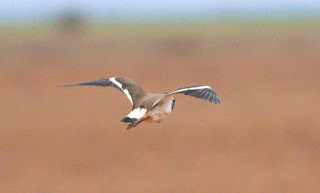The following is the transcript of my news feature in The Weekend
Australian of 10-11 February, 2024.
![]() |
| Coxen's Fig-Parrot |
A 17-year-old
mystery surrounding the identity of a tiny parrot is having
unforeseen consequences for the welfare of endangered Australian
wildlife. Self-promotion by high profile individuals and poor
decision-making by Queensland Government authorities have combined to
threaten rare and mysterious species, and deep divisions within the
natural history community are laid bare.
Just one variety of
bird, the paradise parrot, is confirmed as having become extinct on
the Australian mainland since European settlement; it was last seen
in the 1930s in south-east Queensland. Now, the fate of three more
birds – the Coxen’s fig-parrot, night parrot and buff-breasted
buttonquail - hangs in the balance. Two of the three are possibly
extinct, contrary to confused government advice, with the third
teetering precariously on the brink.
![]() |
| Buff-breasted Buttonquail |
The celebrated
naturalist Steve Irwin died in September 2006 when he was struck in
the heart by a stingray barb on the Great Barrier Reef. Soon after,
as a journalist working for The Australian, I was phoned by Tom
Biggs, a Brisbane medical specialist who was providing commercial
advice to controversial north Queensland naturalist John Young and
his company, John Young Enterprises. Biggs asked if I was interested
in breaking a “really big” story for this masthead concerning
Young and a parrot; no further details were offered.
Biggs and Young were
aware I had publicly suggested the Coxen’s fig-parrot might be
extinct. The brightly coloured parrot once frequented the
rainforests of south-east Queensland and north-east New South Wales
but there had been no confirmed records of the bird for three decades
at the time. Young claimed in the 1990s to have photographed the
fig-parrot in NSW but did not produce convincing images. Young also
asserted in the 1970s that he found a population of paradise parrots
in north Queensland, but no evidence was forthcoming. Assuming Young
was again claiming to have rediscovered the Coxen’s fig-parrot or
paradise parrot, I politely declined Biggs’s offer.
![]() |
| Night Parrot |
A few days later, in
November 2006, Brisbane’s The Courier Mail newspaper splashed the
story across its front and inside pages. It was not about those two
birds but something more eye-catching: Young had supposedly
discovered a species of parrot unknown to science - the blue-browed
fig-parrot. The “discovery” was announced amid much fanfare at a
function at O’Reillys Guesthouse in the Gold Coast hinterland by
Queensland Environment Minister Lindy Nelson-Carr. Scientists from
the state government’s threatened species unit hailed the discovery
as ground-breaking and pledged to work with Young on publishing
scientific papers.
But it wasn’t
true. Investigations by The Australian, aided by Melbourne
ornithologists Jeff Davis and Andrew Isles, indicated that Young’s
image was an altered photograph of a much more common species – the
double-eyed fig-parrot from north Queensland. Gale Spring, a
leading forensic photographic expert, concluded there was little
doubt the image was altered. Ornithological experts from a range of
disciplines were unanimous in dismissing the claim. The Queensland
Government withdrew its support for Young.
![]() |
| John Young |
Young’s large
number of supporters in the wider natural history community were
furious. Fellow North Queensland naturalist and author Lloyd Nielsen
declared on the online platform birding-aus that articles in The
Australian were “despicable”, insisting Young’s claim was
genuine: “This special bird really does exist as depicted in the
published photograph.”
Now it is possible
to throw further light on the matter. Nielsen relates how the day
after the O’Reilly’s announcement, he and others were led by
Young on a long hike through Lamington National Park to be shown a
“blue-browed fig-parrot nest”. Young pointed to a small hole at
the top of a tall tree and said it was the nest entrance. When no
birds appeared after a short time, the group headed back. Nobody saw
the bird, including government scientists who had endorsed Young’s
claims.
Young pledged on his
website in February 2007 to produce a "body of evidence,
including photographs of multiple birds, recordings and biological
material together with a nest site" at some future date. The
evidence has failed to materialise 17 years on, but many nature
enthusiasts continue to believe Young’s new parrot is out there.
The big unanswered question: “Why would a claim like this be
manufactured?”
![]() |
| Lloyd Nielsen |
Young has told me
and others in recent years that the bird he photographed was in fact
a Coxen’s fig-parrot. He admitted that his claims of a new species
were bogus. Young showed me a photograph of a dead bird in a nest
hollow that resembled a Coxen’s fig-parrot - a species that has
never been photographed. Nielsen told me he was also aware the new
species claim was false, even when he was publicly asserting the
opposite. Nielsen remains unsure if Young photographed a Coxen’s
fig-parrot or if he “coloured in” a double-eyed fig-parrot image.
Colours aside, parrot experts point to descriptive features, such as
the bill shape in the pictured bird, indicating a double-eyed
fig-parrot.
Young and Nielsen
say Young succumbed to pressure to make his false claim. There were
discussions about him emerging as the “new Steve Irwin” after the
naturalist’s death and that a natural history discovery of epic
proportions was needed to boost his profile. Something sexier than a
Coxen’s fig-parrot. Young told me his “commercial backers”
hatched the idea that he discovered a new species. Nielsen agrees,
insisting he and Young did not want to go along with the ruse.
![]() |
| Coxedn's Fig-Parrot specimens (Neil Hart) |
Tom Biggs rejects
the suggestion that he urged Young to manufacture the parrot claim.
Biggs tells Inquirer: “I am far from an expert. I don’t have
100th the experience that John has, and I am disinclined to think it
was my suggestion. I have no recollection of suggesting it was a new
species. I doubt that I would have suggested that on the basis of
John’s claim, based on a photograph, that it was a different
species from Coxen’s.” Biggs adds: “To the extent that he
photo-shopped or deliberately manipulated colours, I wouldn’t know.
It’s easily done these days.”
Young and Nielsen
are among many naturalists who insist the Coxen’s fig-parrot is
doing well in the wild. That view resounds with officialdom:
Queensland Government threatened species experts – the same ones
who believed in Young’s blue-browed fig-parrot - insist there are
scores of reliable records of the species in recent decades. In 2018,
the state took the extraordinary step of downgrading the status of
the fig-parrot from Critically Endangered on the basis that its
estimated population of between 50 and 250 had not changed for many
years. The estimate was and remains misguided; not one of the reports
has been confirmed by a photograph, sound recording or other
evidence. The downgrading was executed at a time when many experts
believe Coxen’s fig-parrot was likely to be extinct.
Young’s focus of
attention shifted soon after the blue-browed fig-parrot debacle when
The Australian revealed in February 2007 that a dead night parrot was
found in Diamantina National Park in north-west Queensland by Robert
“Shorty” Cupitt, a bulldozer operator. The bird was decapitated
by flying into a barbed wire fence. Other than another dead bird
found in 1990, also in north-west Queensland, the night parrot had
not been reliably recorded for a century. At the time, it was
considered more rare and mysterious that the Coxen’s fig-parrot.
![]() |
| John Young at the site where he photographed the Night Parrot in 2013 |
The Queensland
Government had suppressed news of this remarkable discovery for
several months, and would have continued to do so indefinitely, while
failing to make meaningful efforts to find and protect populations of
birds in the wake of Cupitt’s find.
The discovery was
potentially a golden opportunity for Young to restore his bruised
reputation by tracking down this enigmatic species - one of just two
nocturnal parrots in the world and apart from Coxen’s fig-parrot,
the only parrot never to be photographed. Young located parrots by
call in the Diamantina area and eventually photographed a night
parrot in 2013 - a remarkable feat that attracted international
recognition. The site where the parrots live was acquired by Bush
Heritage Australia and called the Pullen Pullen Reserve. BHA and the
Australian Wildlife Conservancy are Australia’s two big
organisations devoted to acquiring properties for wildlife
conservation.
Young’s initial
close working relationship with BHA was short-lived and he was hired
by AWC to search for night parrots. Young quit the AWC in 2018 when
an inquiry commissioned by the organisation expressed doubts about
photographs he claimed to be of night parrot nests and eggs. The
inquiry doubted Young’s claims to have discovered the parrot in
South Australia. The AWC ditched two years’ worth of material that
Young had gathered. Nielsen again came to his defence, saying at the
time: “It's shameful that all that work was discarded.” Young
continues to claim new night parrot records: in a blog post last
April, he said he had discovered birds at 11 additional sites in
outback Queensland since his 2013 photographs.
![]() |
| Fence at Pullen Pullen where a Night Parrot was killed |
Parrot experts
believe Young and his backers have set back the cause of night parrot
conservation with unsubstantiated claims of finding them at multiple
sites. “Young’s data was being used to inform decisions about
funding and planning for night parrot conservation,” Australian
National University researcher Penny Olsen told the ANU Reporter last
March. “The bird might feel mythical but it lives in the real
world, and the consequences of misrepresenting its population size
and distribution are serious.” Young and Nielsen declined to
respond to requests to comment.
At Pullen Pullen,
the outlook is bleak: the total parrot population was estimated in
2022 to be between 10 and 20. Numbers have not increased since the
2013 photographs, and surveys have failed to locate additional
populations in Queensland. BHA refuses to say what the population is
now, or to comment on whether a recent explosion of feral cat numbers
on and around Pullen Pullen has had adverse consequences for the tiny
population.
In 2019, another
night parrot was killed after flying into a barbed wire fence on
Pullen Pullen; the fatality may have constituted between 10 and 20
percent of the population. Barbed wire fences on the property
separate night parrot roosts from each other and from surrounding
feeding grounds. Fences are located within a few hundred metres of
parrot roosts. BHA built a new barbed wire fence along Pullen
Pullen’s western boundary in 2017.
![]() |
| Entrance to Pullen Pullen |
Useful data was
provided when researches in the reserve put transmitters on two night
parrots which were tracked, one in 2015 and one in 2016. That work
revealed parrots fly long distances at night from day roosts to
feeding grounds. Pullen Pullen researchers travelled to Western
Australia to do the same with a third bird at a newly discovered site
in 2018. As lead researcher Nick Leseberg told podcast host Thomas
Doerig in 2022: “We went over there, put the tag on it and never
saw it again. It flew away and disappeared.” Extensive searches
failed to find the bird and it was not heard calling again at its
roost.
BHA has now thrown a
veil of secrecy over its Pullen Pullen operations. The organisation
will not say if other parrots have died on barbed wire fences or been
lost after being fitted with transmitters. “Unfortunately none of
our staff are available to help with this story,” said BHA spokeswoman Coco McGrath. BHA has in the past declared
that its operations are “utterly transparent”, but the secrecy
surrounding the night parrot that kicked off with Cupitt’s find
continues. BHA has the back of the Queensland Government, which
introduced a $353,400
fine or two-year jail
sentence for entering
the 56,000ha Pullen Pullen Reserve without permission.
![]() |
| Double-eyed Fig-Parrot |
John Young had been
through the windmill with the Coxen’s fig-parrot and night parrot
controversies. Next he set his sights on the third critically
endangered species in this saga – the buff-breasted buttonquail.
Young and Nielsen claimed to have had multiple encounters with the
small ground bird since the early-1990s in a large area of woodland
north of the Atherton Tableland in north Queensland. Those reports
set the birding world on fire. Hundreds of bird enthusiasts from
around the world claimed to have spotted the buttonquail after
travelling to the area.
It was seemingly a
mirage. Again, not a single record was supported by a photograph or
other evidence. University of Queensland researcher Patrick Webster
undertook extensive surveys of the area and found no evidence of the
bird’s presence, instead repeatedly seeing a closely related and
much more common species - the painted buttonquail. Webster and his
colleagues conclude that none of the reports are likely to be
genuine.
![]() |
| Painted Buttonquail |
This made no
difference to Queensland Government authorities which, largely on the
basis of records from Young and Nielsen, refused over many years to
upgrade the status of the species to Critically Endangered. The last
confirmed record of the bird was in 1922, when specimens were
collected near Coen on Cape York. The government’s faith in the
integrity of claims by the two naturalists was unaffected by the
fig-parrot and night parrot rows.
In the face of
Webster’s research, Young and Nielsen doubled down on their
buttonquail records. Like the night parrot until 2013 and the Coxen’s
fig-parrot, the buttonquail had never been photographed. But Young
said he had photographs of the nest and eggs of a buff-breasted
buttonquail as well as multiple images of the bird itself, which he
shared with Nielsen. In July
2022 Inquirer called into question a published image of what Young
described as a buff-breasted buttonquail nest
that proved to be the
nest of a painted buttonquail.
![]() |
| The nest that John Young claims to be that of a Buff-breasted Buttonquail |
I later published
one of his images of the bird on my blog, sunshinecoastbirds. Experts
agreed it was likely a painted buttonquail. Nielsen again responding
angrily, saying on Facebook he was “thoroughly disgusted” at what
he described as “gutter journalism”. However, following these
revelations, the Queensland Government was finally motivated to
intervene and upgrade the status of the buff-breasted buttonquail to
Critically Endangered, in November 2022. At the same time, it
reversed its 2018 decision to downgrade the status of Coxen’s
fig-parrot, restoring it to Critically Endangered. It may be too
late, however, for all three special birds.

.jpg)
.jpg)


.jpeg)








.jpg)

.jpg)




.jpg)
%20sunbird%20(winneba).jpg)


.jpg)


.jpg)
.jpg)
.jpg)
.jpg)
.jpg)


.jpg)
.jpg)
.jpg)







.jpg)



.jpg)



























































































































































































































































































































































.jpg)






.png)